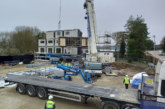 Chris Holleron, Group Product Manager – Construction for Hadley Group, looks at the challenges behind the uptake of modular construction in housing and outlines how it can speed up the build process and reduce costs.
Chris Holleron, Group Product Manager – Construction for Hadley Group, looks at the challenges behind the uptake of modular construction in housing and outlines how it can speed up the build process and reduce costs.
We are all familiar with the well-coined phrase, ‘If it ain’t broke, don’t fix it’. But what if it is broken, as with the UK’s housing market where demand is by far outstripping supply?
Light gauge steel frame, pre-cast concrete and timber-based systems are being successfully used in construction projects throughout the country delivering multiple efficiencies onsite. It has been demonstrated that these modern materials can speed up the build process and reduce costs. However, the uptake of such Modern Methods of Construction remains comparatively slower within housing development, a sector known to be firmly rooted in tradition and slow to adopt change.In order to meet the Government’s ambitious housebuilding targets, housing associations and councils must increase the availability of good quality homes in communities across the country and quickly. While there is no single method or solution that will totally address the need for quality affordable housing, new options must be considered.
Cost and uncertainty remain major barriers to the uptake of offsite manufacture in housing, with not enough projects yet complete to deliver robust lessons as to its suitability for the sector. This reluctance is in many ways understandable, particularly when it disrupts a deeply rooted traditional approach that could affect a well-established supply chain. That is why we need innovators to step forward to help drive this change and build sufficient cases that will demonstrate its worth in real, measurable data.
The Government also needs to play its part and adjust the planning system to make it more feasible to build modular. Joint ventures should also be encouraged as these will go a long way to generating economies of scale because, for many housing providers, financial regulations can be an immediate back stop to even exploring potential offsite or modular solutions.
Quantifying the benefits
It is easy to list the benefits of light gauge steel framing in modular housing construction, particularly when it comes to the impact it can have on build time and project costs. But the next step for the supply chain is to be able to quantify this in real terms, to provide the proof of concept that it really is a viable solution, which could be done by consolidating all the information that would truly demonstrate initial outlays versus whole life costs. But this will require a collaborative approach between all stakeholders from housing providers and developers through to manufacturers and contractors.
From a commercial perspective, we are perhaps part of the barrier when it comes to cost concerns. We cannot agree to the pay-on-completion terms that housing providers look for. Similarly, from a contractor’s perspective, they are also reluctant to take such terms on, as they are not confident about costing a job in an area they have not worked in before. This is why it is so important to look at things more holistically, taking into account wider cost savings. For example, when using lightweight, high-strength profiles, loads on both foundations and any supporting structure can be minimised. Reducing the foundation load means a shallower foundation is required, saving significant time and initial site preparation costs.
There has definitely been more of a shift in the level of commitment by private housebuilders on the take up of modular construction than local authorities, with many private developers having committed 20% capacity for offsite delivery. Is it therefore time to really study these projects as they progress, in order for the industry to present real data to demonstrate where modern methods can really deliver when it comes to time and cost efficiencies? Will that be enough to persuade some of the more reluctant social housing providers and developers to break the mould and lead the way?
Offsite manufacture may not always be the answer — one size does not fit all — but it can definitely play its part in tackling some of the housing problems the country faces.









